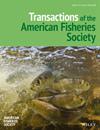大型蓄水流域水蛭引种系与本地系的遗传群体结构
IF 1.4
3区 农林科学
Q2 FISHERIES
引用次数: 0
摘要
摘要:Kokanee是一种非溯河生活史形式的湖泊生物,栖息在流入北太平洋的流域。由于水电大坝的建设,河流被蓄水后,科卡尼也被广泛引入水库。在实施流域级渔业管理策略时,应识别和评估科卡尼遗传差异亚群。我们分析了不列颠哥伦比亚省中北部威利斯顿流域的Kokanee的遗传种群结构,在20世纪90年代哥伦比亚河原产鱼类放养之前,该地区的水库和源头湖泊中就存在当地种群。利用微卫星标记,我们确定本地Williston水库Kokanee只与一个源湖种群不同。源湖的本地种群与水库种群完全分离,没有迹象表明过去或现在与引进种群的渗入。我们将2006年至2019年收集的所有鱼确定为引入的哥伦比亚河起源基因型,并且没有证据表明产卵地点存在遗传差异。由于自2000年以来,当地的Williston Kokanee在调查工作中没有从水库中采样,因此很可能由于与引入的哥伦比亚河起源谱系的竞争,该种群已经从水库中灭绝。本文章由计算机程序翻译,如有差异,请以英文原文为准。
Genetic population structure of introduced and native lineages of Oncorhynchus nerka in a large impounded watershed
Abstract Kokanee, the non‐anadromous life‐history form of Oncorhynchus nerka , use lacustrine habitat in watersheds draining into the north Pacific Ocean. Kokanee also have been widely introduced into reservoirs following impoundment of rivers consequent to the construction of hydroelectric dams. Genetically divergent subpopulations of Kokanee should be identified and evaluated when implementing watershed‐level fishery management strategies. We analyzed the genetic population structure of Kokanee in the Williston watershed, north‐central British Columbia, where native populations were present in the reservoir and headwater lakes prior to stocking Columbia River‐origin fish in the 1990s. Using microsatellite markers, we determined that native Williston Reservoir Kokanee were divergent from only one of the headwater lake populations. Native populations in headwater lakes remain entirely separate from the reservoir populations, and there was no indication of past or current introgression with the introduced stock. We identified all fish collected from 2006 to 2019 as introduced Columbia River‐origin genotypes, and there was no evidence of genetic divergence by spawning location. As native Williston Kokanee have not been sampled from the reservoir in survey efforts since 2000, it is likely that this population has been extirpated from the reservoir perhaps through competition with the introduced Columbia River‐origin lineage.
求助全文
通过发布文献求助,成功后即可免费获取论文全文。
去求助
来源期刊
CiteScore
2.90
自引率
7.10%
发文量
48
审稿时长
8-16 weeks
期刊介绍:
Transactions of the American Fisheries Society is a highly regarded international journal of fisheries science that has been published continuously since 1872. It features results of basic and applied research in genetics, physiology, biology, ecology, population dynamics, economics, health, culture, and other topics germane to marine and freshwater finfish and shellfish and their respective fisheries and environments.

 求助内容:
求助内容: 应助结果提醒方式:
应助结果提醒方式:


